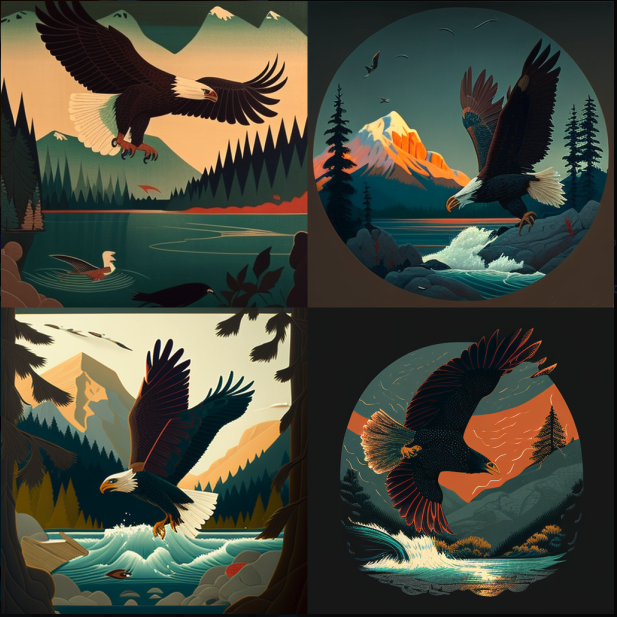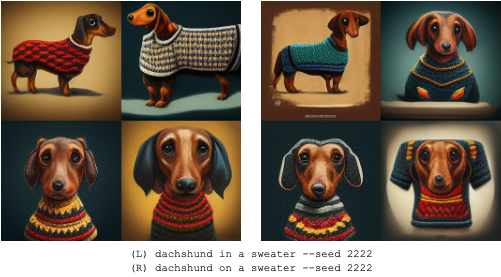🖼 MidJourney
Midjourney is an AI image generator, which is all about imagination. The images are stunning, highly stylized and is for artists to rapidly prototype artistic concepts with AI.
Like other generators, MidJourney uses randomness and a large collection of images to create its pictures. This means that your image will be different every time.
If you want to see some beautiful MidJourney art, check out the showcase.
MidJourney creates highly stylized images, which can be based on artist specific styles. Below is an example of a midjourney image with the prompt an environment design with a bald eagle catching a salmon by Agnes Lawrence Pelton.

Process
Because MidJourney is trained on lots of different types of Art, it offers many options to create highly stylized images. The process for midjourney is similar to that with other image generators.
One way to get more ideas for prompts is to look at the MidJourney showcase, the lab publishes some of the coolest pictures on this page. It's extremely helpful for you to nail down your prompt.
If you want a deep dive into writing MidJourney prompts, check out A very unofficial midjourney manual. MidJourney is probably the most fun tool to play with 🙂.
Content Type
When you approach creating a piece of artwork, the first thing to think about is what is the type of artwork you want to achieve, is it a Photograph, Drawing, Sketch or 3D render?
Make a decision, here and specify the content type. This can be anime, photorealistic, phtoograph, portrait, halftone, 3d rendering, painting
Description
A description refers to defining the subject, subject attributes, and the environment/scene. The more descriptive you can be with the use of adjectives the better the output. Use the descriptions to add details about ht enrivonment or scene.
This is where you can have the most effect on the content of the image. If you want to make changes to the description, first shift the order of items.
Style
This is where you can get really creative. Think of style in three categories; Lighting, Detail and Art. You can also use various artist styles, as shown in this document to give your work an artist specific touch.
MidJourney is incredibly sensitive to style cues, even when at the end of a sentence.
Lighting Below are lighting styles you can use to change your MidJourney Image.
accent lighting, backlight, blacklight, blinding light, candlelight, concert lighting, crepuscular rays, direct sunlight, dusk, Edison bulb, electric arc, fire, fluorescent, glowing, glowing radioactively, glow-stick, lava glow, moonlight, natural lighting, neon lamp, nightclub lighting, nuclear waste glow, quantum dot display, spotlight, strobe, sunlight, ultraviolet, dramatic lighting, dark lighting, soft lighting
Detail Below are details you can use to change your MidJourney image.
highly detailed, grainy, realistic, unreal engine, octane render, bokeh, vray, houdini render, quixel megascans, depth of field (or dof), arnold render, 8k uhd, raytracing, cgi, lumen reflections, cgsociety, ultra realistic, volumetric fog, overglaze, analog photo, polaroid, 100mm, film photography, dslr, cinema4d, studio quality
Art Below are words you can use to describe art styles in MidJourney.
Abstract, Medieval art, Renaissance, Baroque, Rococo, Neoclassicism, Romanticism, Impressionism, post-Expression, Cubism, Futurism, Art Deco, Abstract Expressionism, Contemporary, pop art, surrealism, fantasy, Digital art, digital painting, color page, featured on pixiv (for anime/manga), trending on artstation, precise line-art, tarot card, character design, concept art, symmetry, golden ratio, evocative, award winning, shiny, smooth, surreal, divine, celestial, elegant, oil painting, soft, fascinating, fine art
Basic MidJourney Tricks
A large part of working with MidJourney is just taking a step back and trying to think less like yourself and more like a silly machine that has never once inhabited the physical world. Remember to be specific 🙂.
Don't go past about 60 words. The tokenizer only sees the first 77 tokens (pieces of words).
in vs. on

MidJourney has a hard time distinguishing between 'in' and 'on'. Instead use more specific words, like; 'inside', 'atop', or in this case 'embroidered on'.
Repeat words
If you aren’t much for flowery language, you can also just emphasize by repeating words, either together (big boost) or at the beginning and end of the prompt (little boost).
Use Emojis 💁♀️
Emojis can be a useful tool for reinforcing certain concepts, such as by using 👫 to increase the chances of getting a couples portrait. They can also add variety to prompts by representing hand gestures and adding a touch of personality.
Experiment with emojis!
Internal state
Now for a quick life lesson cleverly disguised as a prompting tip: "beautiful" is a word that gets thrown around a lot, especially when talking about portraits of women. But think about all the things that can be considered beautiful - a sunset, a cathedral, even a plastic bag caught in the wind. They all lack a face!
When crafting your prompts, it's better to focus on the subject's internal state rather than the viewer's perception. Using a word like "confident" will yield better results than "beautiful" because it guides the subject towards images of a whole face, rather than just a general, viewer-dependent mood.
Parameters
Seed
A seed number generate the random starting value used in the begining of image generation. Using the same number across multiple prompts will use the same starting noise.
--seed [your favorite number]
Aspect Ratio
Aspect Ratio is a real game-changer in the world of prompts, MJ is picky about how it affects composition. For example, if you want a full-body shot of a person, a vertical aspect ratio will make your life easier. But if you're looking to fit multiple subjects in one frame, choose widescreen.
Aspect Ratio totally alters the randomness generated by the initial seed number. So, two prompts, one at default square and one at --ar 16:9 will look vastly different from each other.
Change it by adding your desired Aspect ratio at the end of the prompt in the format, --ar [whatever it may be: 16:9, 4:3 etc..]
Stylize
The stylize parameter is like the secret sauce in MJ's "house style" recipe. The higher the value, the more influence MJ has over your prompt, but be careful not to overdo it or you might get ignored entirely. This "house style" is a combination of developer magic and user feedback, which gets incorporated into the algorithm when they train a new version.
It's worth taking the time to understand this parameter, as it comes with some trade-offs. The biggest perk is increased coherence. If you have a prompt that's a bit too sketchy or vague, like a complex machine or a crowd of people, a little boost to stylize can work wonders. It's the closest thing to a "make it look cool" button you'll find among the parameters.
Change the stylize by adding your desired value at the end of the prompt in the format, --s [0-1000]